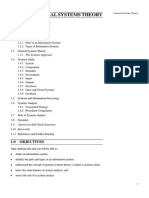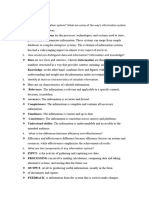IS Exp
IS Exp
Uploaded by
AngelicaCopyright:
Available Formats
IS Exp
IS Exp
Uploaded by
AngelicaOriginal Title
Copyright
Available Formats
Share this document
Did you find this document useful?
Is this content inappropriate?
Copyright:
Available Formats
IS Exp
IS Exp
Uploaded by
AngelicaCopyright:
Available Formats
COMPUTER
Introduction
Many organizations work with large amounts of data. Data
are basic values or facts and are organized in a database. Many
people think of data as synonymous with information; however,
information actually consists of data that has been organized to help
answers questions and to solve problems. An information system is
defined as the software that helps organize and analyze data. So, the
purpose of an information system is to turn raw data into useful
information that can be used for decision making in an organization.
General Purpose vs. Specialized Information Systems
There are some general types of information systems. For
example, a database management system (DBMS) is a combination
of software and data that makes it possible to organize and analyze
data. DBMS software is typically not designed to work with a specific
organization or a specific type of analysis. Rather, it is a generalpurpose information system. Another example is an electronic
spreadsheet. This is a tool for basic data analysis based on formulas
that define relationships among the data. For example, you can use a
spreadsheet to calculate averages for a set of values or to plot the
trend of a value over time.
In contrast, there are a number of specialized information
systems that have been specifically designed to support a particular
process within an organization or to carry out very specific analysis
tasks. For example, enterprise resource planning (ERP) is an
information system used to integrate the management of all internal
and external information across an entire organization. Another
example is a geographic information system (GIS), which is used to
manage and analyze all types of geographical data. Expert systems
are another example of information systems. An experts system is
designed to solve complex problems by following the reasoning of an
expert.
Typical Components of Information Systems
While information systems may differ in how they are used within an
organization, they typically contain the following components:
1. Hardware. Computer-based information systems use computer
hardware, such as processors, monitors, keyboard, and printers.
2. Software. These are the programs used to organize, process and
analyze data.
3. Databases. Information systems work with data, organized into
tables and files.
4. Network. Different elements need to be connected to each other,
especially if many different people in an organization use the same
information system.
5. Procedures. These describe how specific data are processed and
analyzed in order to get the answers for which the information system
is designed.
The first four components are part of the general
information technology (IT) of an organization. The procedures are
very specific to the information needed to answer a specific question.
Information systems is in essence bridging the gap
between business and the ever growing field of computers. On the
other hand, information technology is all about managing technology
and making use of it for the betterment of business.
In brief:
Information systems and information technology are parts
of a broader computer science.
Whereas information systems focuses on the system
making use of technology, information technology focuses on
technology and how it can help in disseminating information.
However, Information technology and information systems
are not necessarily two fields of study, even though, there can be
fields of studies on these terms.
MEANING
Information system
An information system can be defined as set of coordinated network
of components, which act together towards producing, distributing
and or processing information. An important characteristic of
computer-based information systems information is precision, which
may not apply to other types.
information technology
Information technology can be broadly defined as integration of
computer with telecommunication equipment for storing, retrieving,
manipulating and storage of data. According to Information
Technology Association of America, information technology is defined
as the study, design, development, application, implementation,
support or management of computer-based information systems.
IMPORTANCE
The emegence of a global economy, transformation of industrial
economies, transformation of the business enterprise, and the
emergence of digital firm make information systems essential in
business today. Information system is a fondation for conducting
business today. In many businesses, survival and the ability to
achieve strategic business goals is difficult without extensive use of
information technology. There are six reasons or objectives why
businesses use information system:
1) Operational Excellence businesses can constantly improve their
efficiency of their operations in order to achieve higher profitability.
They can do this by constantly having the correct amount of stock in
store so consumers can always get want they want.
2) New product services and business models I.S systems play a
major role for businesses in creating new products and services. New
business models can be created and these can describe how a
company produce, create and sell there products.
3) Customer and Supplier intimacy the better services a company
provides its consumers with more likely they are too come back to
them and as result the more they will buy off the supplier therefore
creating a good relationship with both parties.
4) Improved decision making I.S systems make it possibly for
managers to use real time data when making a decision to therefore
make better decisions and not have to waste time looking for
information.
5) Competitive advantage if companies achieve any of these 6
reasons to use I.S they will generally create a competitive advantage
over their rivals.
6) Day to Day survival business invest in these systems to make
their jobs as easy as possibly. an example is Citibank introduced the
first ATM machine to make it easier for customers to access their
money and to cut down queues in their banks.
You might also like
- Solution Manual For Mis 10th Edition Hossein BidgoliDocument18 pagesSolution Manual For Mis 10th Edition Hossein BidgoliOwen Wilkerson100% (44)
- Willingness To Pay For Kigamboni Bridge Service REPORT-1Document71 pagesWillingness To Pay For Kigamboni Bridge Service REPORT-1amedeus chuwaNo ratings yet
- Pas 17Document6 pagesPas 17AngelicaNo ratings yet
- Reddy Last NamesDocument17 pagesReddy Last NamesAnonymous 9Ojih3mNo ratings yet
- Three Primary Uses of Information SystemsDocument5 pagesThree Primary Uses of Information SystemsInnoe malon Machinga100% (1)
- MIS Unit 1Document51 pagesMIS Unit 1ArchitNo ratings yet
- Mis Irm Ch01.TghDocument18 pagesMis Irm Ch01.TghSandisoNo ratings yet
- Information SystemDocument8 pagesInformation SystemMUNEEBA GULNo ratings yet
- Whole Notes Combine Canvas PDFDocument17 pagesWhole Notes Combine Canvas PDFKhevana PurohitNo ratings yet
- Spreadsheet. This Is A Tool For Basic Data Analysis Based On Formulas That Define Relationships Among The Data. For Example, You CanDocument7 pagesSpreadsheet. This Is A Tool For Basic Data Analysis Based On Formulas That Define Relationships Among The Data. For Example, You CanCho KyulaNo ratings yet
- Q1) Define Information System and Its ScopeDocument4 pagesQ1) Define Information System and Its ScopeIrsa KhanNo ratings yet
- Fundamentals of Is Week 2Document19 pagesFundamentals of Is Week 2vmera23No ratings yet
- Introduction To Information SystemsDocument5 pagesIntroduction To Information Systemsabbynimmo2013No ratings yet
- Akang Activity1Document2 pagesAkang Activity1Shyrene Kaye AlladoNo ratings yet
- 12ba25 Management Information System Unit-I: Data, Information, Knowledge and IntelligenceDocument11 pages12ba25 Management Information System Unit-I: Data, Information, Knowledge and Intelligencechanus01No ratings yet
- Information System (IS) Is The Study of Complementary Networks of Hardware and SoftwareDocument9 pagesInformation System (IS) Is The Study of Complementary Networks of Hardware and SoftwareRashi GurnaniNo ratings yet
- INformstion SystemsDocument20 pagesINformstion SystemsvikeeeeeNo ratings yet
- PrE4 Module 1Document8 pagesPrE4 Module 1Galang, Princess T.No ratings yet
- REVIEW QUESTION - Docx JennyDocument5 pagesREVIEW QUESTION - Docx JennyhirayafranciffNo ratings yet
- PlanningDocument11 pagesPlanningSwati SinghNo ratings yet
- The 6 Types of Information Systems and Their ApplicationsDocument46 pagesThe 6 Types of Information Systems and Their ApplicationsShwa BeliNo ratings yet
- Introduction To Management Information SystemDocument4 pagesIntroduction To Management Information SystemHARIKIRAN PRNo ratings yet
- Information SystemDocument51 pagesInformation SystemVkNo ratings yet
- CS507 Information System Short NotesDocument56 pagesCS507 Information System Short NotesSaad RazaNo ratings yet
- Management Information System UNIT 1Document26 pagesManagement Information System UNIT 1Kavipriya ShankarNo ratings yet
- MC0076 (C)Document19 pagesMC0076 (C)akibond999No ratings yet
- W2L12 ScriptDocument15 pagesW2L12 ScriptRameshNo ratings yet
- Information System Defining Information SystemsDocument27 pagesInformation System Defining Information SystemsFidelis GodwinNo ratings yet
- Mis 2011Document45 pagesMis 2011Ujwal_K_Centra_2636No ratings yet
- AIT-Open University: AssignmentDocument10 pagesAIT-Open University: AssignmentPrince George IIINo ratings yet
- What Is Information SystemDocument2 pagesWhat Is Information SystemGrace FuentesNo ratings yet
- Marketing Information Chapter OneDocument11 pagesMarketing Information Chapter OnehenokNo ratings yet
- Types of Management Information SystemsDocument15 pagesTypes of Management Information SystemsAeros Padua50% (2)
- Information System:-: IT in IndustryDocument7 pagesInformation System:-: IT in Industryalok006No ratings yet
- The State Railway System': Information InformationDocument13 pagesThe State Railway System': Information InformationKhondoker Razzakul HaqueNo ratings yet
- Acharya Institute of Graduate Studies Department of Management EVEN SEMESTER 2012 - 2013Document15 pagesAcharya Institute of Graduate Studies Department of Management EVEN SEMESTER 2012 - 2013JayaJayashNo ratings yet
- Management Information Systems AssignmentDocument13 pagesManagement Information Systems AssignmentRoshni VinodNo ratings yet
- What Are The Types of Information System ApaDocument16 pagesWhat Are The Types of Information System ApaAbeer AlshebamiNo ratings yet
- Information System (Is)Document27 pagesInformation System (Is)Pooja RaiNo ratings yet
- Management Information SystemDocument7 pagesManagement Information SystemAkhilASNo ratings yet
- Management Information System Example ThesisDocument6 pagesManagement Information System Example Thesisfbyhhh5r100% (2)
- Management Information SystemDocument22 pagesManagement Information SystemHaydee Christine SisonNo ratings yet
- Chapter 2 - Types of Information SystemsDocument10 pagesChapter 2 - Types of Information SystemsNgong ConstantineNo ratings yet
- Mis & ErpDocument11 pagesMis & Erpkar3kNo ratings yet
- MIS-Unit 1Document47 pagesMIS-Unit 1ghimirebob1998No ratings yet
- Business Communication Assignment 02Document9 pagesBusiness Communication Assignment 02Aiou MSCNo ratings yet
- Data Flow Diagrams Processes: Name: Amit Pathak ROLL NO: 1302016570Document6 pagesData Flow Diagrams Processes: Name: Amit Pathak ROLL NO: 1302016570pkm7929No ratings yet
- MIS-Unit 1Document61 pagesMIS-Unit 1BhagwatiNo ratings yet
- FINAL - Các CN dựa trên nền CNTTDocument38 pagesFINAL - Các CN dựa trên nền CNTTVân Anh TrầnNo ratings yet
- Information Reporting System and Executive Information SystemDocument9 pagesInformation Reporting System and Executive Information SystemBoobalan RNo ratings yet
- MIS Chapter 1 - Information SystemsDocument4 pagesMIS Chapter 1 - Information Systemsstephenwainaina994No ratings yet
- Components of Information SystemDocument5 pagesComponents of Information Systemsubbu2raj33720% (1)
- Management Information SystemDocument5 pagesManagement Information Systemsudhakar3456No ratings yet
- Unit 01Document9 pagesUnit 01harsh hariharnoNo ratings yet
- Introduction to information systemDocument4 pagesIntroduction to information systemNiroj ThapaNo ratings yet
- Assignment: Management Information Systems: Roll No. BS-IAS-184-F17 Section BDocument3 pagesAssignment: Management Information Systems: Roll No. BS-IAS-184-F17 Section BMalick Sajid Ali IlladiiNo ratings yet
- Reviewer in Itab 2100Document7 pagesReviewer in Itab 21006r6s7b4kgcNo ratings yet
- Introduction To Management Information SystemsDocument13 pagesIntroduction To Management Information SystemsYus MartianNo ratings yet
- CBISDocument6 pagesCBISNida HassanNo ratings yet
- ABI Summary LUsDocument35 pagesABI Summary LUsh9rkbdhx57No ratings yet
- Zero To Mastery In Cybersecurity- Become Zero To Hero In Cybersecurity, This Cybersecurity Book Covers A-Z Cybersecurity Concepts, 2022 Latest EditionFrom EverandZero To Mastery In Cybersecurity- Become Zero To Hero In Cybersecurity, This Cybersecurity Book Covers A-Z Cybersecurity Concepts, 2022 Latest EditionNo ratings yet
- PAS38 TheoriesDocument3 pagesPAS38 TheoriesAngelicaNo ratings yet
- GSIS Case StudyDocument10 pagesGSIS Case StudyAngelica0% (1)
- Table of Contnts - SSHDocument4 pagesTable of Contnts - SSHAngelicaNo ratings yet
- PAS37 ProbsDocument4 pagesPAS37 ProbsAngelicaNo ratings yet
- Research Paper TemplateDocument2 pagesResearch Paper TemplateAngelicaNo ratings yet
- Final CompileDocument37 pagesFinal CompileAngelicaNo ratings yet
- Pas 37Document5 pagesPas 37Angelica100% (2)
- Pas 11Document2 pagesPas 11AngelicaNo ratings yet
- PAS37 TheoriesDocument7 pagesPAS37 TheoriesAngelicaNo ratings yet
- Financial Budget 2. Marketing Strategies (Logo, Tagline, Layout)Document1 pageFinancial Budget 2. Marketing Strategies (Logo, Tagline, Layout)AngelicaNo ratings yet
- Pas 38Document8 pagesPas 38AngelicaNo ratings yet
- Measuring and Recording Manufacturing Overhead CostDocument2 pagesMeasuring and Recording Manufacturing Overhead CostAngelicaNo ratings yet
- Sweets Singer Haus: Meeting Agenda Objectives: General: SpecificDocument1 pageSweets Singer Haus: Meeting Agenda Objectives: General: SpecificAngelicaNo ratings yet
- A Project Proposal: Manila Doctors Hospital Leave Management SystemDocument13 pagesA Project Proposal: Manila Doctors Hospital Leave Management SystemAngelicaNo ratings yet
- Competitor's ProfileDocument3 pagesCompetitor's ProfileAngelica50% (2)
- LECTURE - 4 CHAPTER 4 Managing in A Global EnvironmentDocument33 pagesLECTURE - 4 CHAPTER 4 Managing in A Global EnvironmentAngelica100% (1)
- Types of Information SystemsDocument1 pageTypes of Information SystemsAngelicaNo ratings yet
- Singing Sweets Haus Business PlanDocument66 pagesSinging Sweets Haus Business PlanAngelica100% (1)
- Contract Ii Case Review (Implied Terms)Document53 pagesContract Ii Case Review (Implied Terms)khairiah tsamNo ratings yet
- Pre-Test 6Document3 pagesPre-Test 6BLACKPINKLisaRoseJisooJennieNo ratings yet
- Safety Datasheet Silver PasteDocument14 pagesSafety Datasheet Silver PastedaaanuNo ratings yet
- SHS Core Subjects Matrix For The Learning Continuity Plan GenMath - DINCYDocument4 pagesSHS Core Subjects Matrix For The Learning Continuity Plan GenMath - DINCYLoraine ReyNo ratings yet
- EPSON 7600 - 9600 Field Repair GuideDocument60 pagesEPSON 7600 - 9600 Field Repair GuideFrancisco José López100% (1)
- Proper Maintenance of Hand ToolsDocument12 pagesProper Maintenance of Hand ToolsJohn Vincent RevocalNo ratings yet
- CPCDocument154 pagesCPCHu ZugNo ratings yet
- Machine Learning and Applications (5L)Document185 pagesMachine Learning and Applications (5L)Ravi RanjanNo ratings yet
- How To Get Your First 10,000 Instagram Followers EbookDocument58 pagesHow To Get Your First 10,000 Instagram Followers EbookPhuong50% (6)
- INFOSYS Placement Paper 2 - Freshers ChoiceDocument20 pagesINFOSYS Placement Paper 2 - Freshers ChoicefresherschoiceNo ratings yet
- EMIS Next Overarching Brochure FY24Document4 pagesEMIS Next Overarching Brochure FY24Alejo MarinuribeNo ratings yet
- Eportfolio Resume CVDocument4 pagesEportfolio Resume CVapi-577441503No ratings yet
- ANNEX 9 Project Work Plan and Budget MatrixDocument2 pagesANNEX 9 Project Work Plan and Budget Matrixraquel asilo100% (3)
- Sat Blaster II 2 16 Tuner S+S2+Decrypt IP DatasheetDocument3 pagesSat Blaster II 2 16 Tuner S+S2+Decrypt IP DatasheetLaszlo ZoltanNo ratings yet
- Mig 3Document88 pagesMig 3seafire47100% (1)
- Aso and BsoDocument17 pagesAso and BsoSobha AttuluriNo ratings yet
- Control Valves BasicsDocument14 pagesControl Valves BasicsSyed Waqas Haider100% (1)
- Crate BT 15 - Parts List PWA Bass Amplifier (848pl - B)Document13 pagesCrate BT 15 - Parts List PWA Bass Amplifier (848pl - B)Guim EloyNo ratings yet
- NCVTCTSCertificateAnnual R210821055642Document1 pageNCVTCTSCertificateAnnual R210821055642rakeshkumar sahuNo ratings yet
- Chapter 5 Reduction of Multiple SubsystemsDocument42 pagesChapter 5 Reduction of Multiple SubsystemsRehan BasharatNo ratings yet
- Bachelor Application File - Psychology 2022-2023Document8 pagesBachelor Application File - Psychology 2022-2023Tam UnoNo ratings yet
- C For Everyone Programming FundamentalsDocument1 pageC For Everyone Programming FundamentalsSuraj KunduNo ratings yet
- Far Eastern University Audit of Cash Auditing C.T.EspenillaDocument13 pagesFar Eastern University Audit of Cash Auditing C.T.EspenillaUn knownNo ratings yet
- Representing and Interpreting DataDocument44 pagesRepresenting and Interpreting DataAllyson CarlosNo ratings yet
- EN Book2Document63 pagesEN Book2Kristina ReitmeierNo ratings yet
- 793F Main SchematicDocument13 pages793F Main SchematicBrian CareelNo ratings yet
- Health Alberta Covid 19 Pandemic Response Review Final ReportDocument126 pagesHealth Alberta Covid 19 Pandemic Response Review Final ReportCTV News EdmontonNo ratings yet
- STEK Claim Form - V1Document11 pagesSTEK Claim Form - V1STEK AutomotiveNo ratings yet












































































































